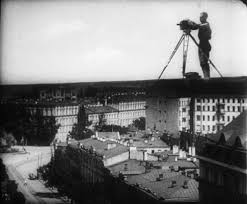Doc mode activity 1: Observational
According to Bill Nichols there are six modes of documentary film making: Expository, Poetic, Observational, Participatory, Performative, And Reflexive. Observational documentaries are exemplified by the filmmaker acting as an invisible object recording the things around them but not influencing them in anyway. Because nothing is staged in these documentaries, the filmmaker must rush to meet the action and record what is happening in real time. This results in the footage often being slightly shaky or amateur looking (Nichols). Another common convention of these documentaries is the lack of music or dialogue. In many ways, Man with a Movie Camera is primarily observational. While the film is very Avant guard and poetic in its editing and music use, Dziga Vertov primary objective is to show life in Russia at the time; focusing of observing daily life by acting as a fly on the wall and filming them.
(Man with a Movie Camera, 1929)
The films that truly exemplify this mode for me are the films of Frederick Wiseman. This Cinema Verite style or Cinema truth is an interesting style of documentary film making because it relies on the audience to create the narrative.
(Titicut Follies 1967)
In High School for example, Wiseman shot of 100 hours of footage of daily life at an American high school. He then, edits the footage together without any music and focuses on the reality of what is happening with the people in his films. In one scene in High School, the camera sits in a low angle in the corner watching a meeting between a principal, the student, and her parents. There are few cuts and it just focuses on the conversation. This results in there being no clear theme or conclusion to these films but the audience takes what they want from the reality that they are seeing.
(High School, 1968)
Taking the common traits of the observational mode of documentary film making I have created a short example which I have linked above. This 2:00 documentary is shot with an iPhone 5 camera at Austin Film Festival’s office in Austin, TX. This vignette depicts the employees and interns in the office two weeks before the festival begins. While the footage itself is shaky and without the use of a proper camera, it encompasses the observational style of documentary film making that was discussed in Nichols’ book Introduction to documentary. I have used no music or narration and simply observed the goings on in the office in order to provide an example of my life as an intern there. In the short, I focus on the building itself and the people in it but do not introduce anyone in the office. I did this to create a sense of reality for someone who was just observing the office objectively. This is unique to the observational mode of documentary because instead of focusing on the particulars to create a overall story arc, this mode acts as a fly on the wall and observes the overall ambiance of a uninterrupted scene.



